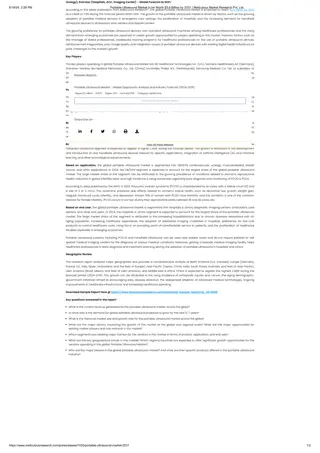Understanding Ultrasound in Biomedical Instrumentation Lab
Ultrasound machines are key tools in biomedical engineering, utilizing sound waves to create images of internal body structures without invasive procedures. This technology finds applications in various medical fields, such as gynaecology, cardiology, neurology, and nephrology. While offering real-time imaging and portability benefits, ultrasound systems have limitations like restricted field of view and dependency on operator skill. Different types of ultrasound systems are available, including portable, high-end, and specialized models tailored to specific medical domains.
Download Presentation

Please find below an Image/Link to download the presentation.
The content on the website is provided AS IS for your information and personal use only. It may not be sold, licensed, or shared on other websites without obtaining consent from the author. Download presentation by click this link. If you encounter any issues during the download, it is possible that the publisher has removed the file from their server.
E N D
Presentation Transcript
Al-Mustaqbal University. College of Engineering and Engineering Technologies. Biomedical Engineering Department. Subject Subject: : Biomedical Instrumentation Lab. Class Class (code) (code): : 5th Lecture Lecture: : 3 3 By By: : Zainab Zainab Sattar Sattar Jabbar Jabbar M M. .SC SC. . IN IN BME BME BME
Ultrasound machine Ultrasound machine An ultrasound is an imaging test that uses sound waves to make pictures of organs, tissues, and other structures inside your body. It allows your health care provider to see into your body without surgery.
Ultrasound applications Ultrasound applications Gynaecology and neonatology Cardiology, to detect ventricular size and heart valve anomalies Neurology for blood flow assessment Nephrology (kidney, bladder) Ultrasound systems can deliver static or dynamic images (e.g. heart valves) liver with cirrhosis liver with cirrhosis (too much alcohol) (too much alcohol) bladder with bladder with cancer cancer blood blood vessels vessels kidney with kidney with cancer cancer
Ultrasound machine Ultrasound machine Advantages include: Advantages include: It provides images in real-time (still and video). it is portable and can be brought to the bedside. it is substantially lower in cost. it does not use harmful ionizing radiation. Drawbacks include: Drawbacks include: various limits on its field of view including o patient cooperation and physique (obese). o difficulty imaging structures behind bone. and its dependence on a skilled operator
Ultrasound Systems Ultrasound Systems Specialized Specialized ultrasound systems are available per application domain, e.g. cardiovascular. General purpose General purpose ultrasound systems may differ in: different transducers color Doppler ultrasound 3D-imaging capability portability
Ultrasound Systems Ultrasound Systems Portable model Portable model High end model High end model Black & white model Black & white model
Construction Construction
Portable ultrasound system (examples) Portable ultrasound system (examples) ultrasound system on ultrasound system on smart phone smart phone portable ultrasound system portable ultrasound system with four transducers with four transducers
Construction Construction A diagnostic ultrasound machine consists of many components, each of which has a separate operation to perform. This starts with transmitting and receiving ultrasound signals which are then processed to form the images that we see on screen. The internal components that make up a typical ultrasound machine are listed below: Transducer Pulser Beam former Receiver Processor Display Digital storage Hard copy printer devices.
Construction Construction
The Transducer The Transducer Diagnostic transducers are made from piezoelectric materials and are able to convert electrical energy into ultrasound energy. As a consequence of this they can act as a transmitter and receiver of ultrasound. They are able to produce beams which can be directed in various ways which are controlled by the ultrasound machine to improve image quality.
The The pulser pulser The pulser produces the electric voltage that drives the transducer. This driving voltage governs the output power of the ultrasound machine and can be adjusted by the operator through the power or output control
Beam Former, Receiver and Beam Former, Receiver and Processor Processor The beam former controls the shape and direction of the ultrasound beam and the scanning patterns used to form the images that we see. The job of the receiver is to combat attenuation. The processor can be divided into two individual parts: A signal processor converts echo voltages to video signals An image processor formats the many scan line data into image form.
Block diagram of the Block diagram of the signal processor signal processor
Construction Construction A high end ultrasound system contains a lot of electronics. Repair cannot be undertaken without guidance of a service manual. The most common problem, next to user and power issues, is poor connections of the PCBs in their connectors/slots.
Corrective Maintenance Highlights Corrective Maintenance Highlights User Error User Error Is enough of the proper ultrasound gel used? Are the controls set correctly? In particular the contrast and brightness buttons! Transducer Transducer Ensure that the transducer is properly connected and undamaged The transducer is sensitive to shocks! If there is defective element, you often see a black line on the image. Transducer cracks cannot be repaired: exchange the transducer. Gently pull on the cable at different points to see when the image flickers. This is where the cable is broken. If cable/connections are broken: fix by soldering Dials/buttons Dials/buttons If buttons don t function properly: replace or use anti-corrosive contact spray on dials. Deteriorating Deteriorating Check mains voltage, check pre-amplifiers, check probe connection, fuses. image quality image quality Is the machine calibrated correctly? the CRT (Cathode Ray Tube) monitor may be worn out after a few years. Replace! A voltage stabilizer may be required in case of varying mains voltage (more than 10%) Electric contact Electric contact Poor electric contacts is a major problem in all electronics devices.
Preventive Preventive Maintenance: Daily & Weekly care Maintenance: Daily & Weekly care Daily Care: Daily Care: Weekly Care: Weekly Care: Clean Clean probe with alcohol-free tissue or cloth Wipe dust of exterior and cover wipe Clean Clean with damp cloth, dry off Visual Check Visual Check are tight. Check that mains cable has no bare wire and is not damaged. Unplug, clean outside / wheels / rear Visual Check Visual Check accessories are mounted correctly. Check that cables are not twisted and the probe is safely stored. Check all fittings and Check that mains plug screws Function Check Function Check If machine has not been in use, run and test briefly. Function Check Function Check If in use that day, run a brief function check before patients arrive. Do not soak the cable with gel! Do not soak the cable with gel!
Preventive Maintenance Checklist: BMET Preventive Maintenance Checklist: BMET Preventive maintenance (BMET, every six months): Preventive maintenance (BMET, every six months): Clean outside Clean outside (if necessary) Visual Check Visual Check Check if all accessories are mounted correctly. Check cables, power & connections. Open system and perform visual check inside the system. Grease & filters Grease & filters Clean grease wheels, replace air filters. Function Check Function Check Check imaging quality with different transducers Calibrate system with phantoms Safety Check Safety Check Check electrical safety
Calibration Calibration phantoms. Different phantoms are used to test different Calibration is performed by means of phantoms performance features such as lateral and axial resolution, and correctness of distance measurements. Based of the ultrasound image of the phantom, the good performance of the system can be confirmed. Transducers cannot be adjusted with respect to their image accuracy. If the test result is not acceptable, the transducer should be replaced. The white dots in the image indicate reflectors at these locations in the phantom. If the reflections do not show up at the correct locations in the image, something is probably wrong with the transducer. Full calibration requires using a range of phantoms to test different aspects of the equipment. Follow the instructions in the service manual. Example of ultrasound Example of ultrasound image of phantom image of phantom Phantom (example) Phantom (example)
Safety Safety Ultrasound diagnostic imaging appears to be risk-free when used properly. Ultrasound transducers transducers should be handled carefully to avoid damage. Electromechanical problems, such as cracks in piezoelectric elements, can alter beam width or sound pulses, thereby affecting resolution. Errors in distance measurements from the images can cause incorrect calculations and thus an incorrect diagnosis.























